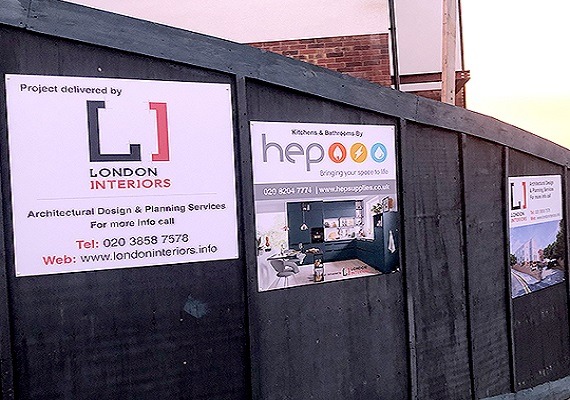In the competitive world of business, making a memorable first impression is crucial. One effective way to achieve this is by incorporating 3D elements into your signage, combined with the durability and sleekness of Dibond printing. Let’s delve into how this combination can transform your brand’s visibility and impact.
What is Dibond Printing?
The Dibond printing involves using aluminium composite panels, known as Dibond, as a medium for high-quality prints. These panels consist of two thin layers of aluminium enclosing a non-aluminium core, making them lightweight yet sturdy. This construction provides a smooth surface ideal for vibrant and detailed prints, ensuring your signage stands out.
Dibond is composed of two 0.3mm thick aluminium sheets surrounding a polyethylene core. This composition offers several advantages:
- Durability: Resistant to weather conditions, making it suitable for both indoor and outdoor applications.
- Lightweight: Maintains strength while being simple to handle and install.
- Smooth Finish: Provides an excellent base for high-resolution printing.

What Materials are Used in 3D Signage?
Incorporating 3D elements into your signage can significantly enhance its visual appeal and effectiveness. Here are some materials commonly used for 3D signage:
- Acrylic: Offers clarity and can be moulded into various shapes, ideal for illuminated signs.
- Foamex: A lightweight PVC foam board, suitable for indoor signs with a smooth finish.
- Aluminium Composite Panels (Dibond): Combines durability with a sleek appearance, perfect for modern designs.
- Stainless Steel: Provides a premium, industrial look with exceptional longevity.
Combining these materials with Dibond printing allows for the creation of robust and visually striking signage that captures attention and withstands the elements.
What Boards are Used for Signage?
Selecting the appropriate board for signage depends on factors like location, desired aesthetics, and budget. Commonly used boards include:
- Foamex Boards: Ideal for indoor use due to their smooth surface and ease of fabrication.
- Dibond Panels: Suitable for both indoor and outdoor applications, offering a balance between weight and strength.
- Correx Boards: Corrugated plastic boards, often used for temporary signage due to their affordability and weather resistance.
- Wooden Boards: Provide a rustic or traditional look, commonly used in heritage sites or rustic-themed establishments.
What is the Difference Between Litho and Digital Printing?
Understanding the distinction between litho and digital printing is essential for choosing the right method for your signage:
| Aspect | Litho Printing | Digital Printing |
| Process | Utilises wet ink and printing plates; involves creating separate plates for each color (CMYK). | Employs dry toner or liquid ink, applying it directly onto the printing surface without the need for plates. |
| Setup Time & Cost | Involves longer setup times and higher initial costs due to plate creation; more cost-effective for large volumes. | Quick setup with lower initial costs, ideal for short runs and on-demand printing. |
| Print Quality | High-quality output, especially for large blocks of solid color; ink soaks into the paper, providing a different finish compared to digital prints. | Good quality suitable for most applications; ink sits on the paper’s surface, which can affect texture and color depth. |
| Speed | Faster for large quantities once setup is complete, capable of printing up to 18,000 sheets per hour. | Suitable for quick turnarounds, printing around 4,800 sheets per hour. |
| Cost Efficiency | More economical for large print runs due to lower cost per unit after setup; initial setup can be expensive. | Cost-effective for small quantities and personalised prints; no setup costs, but higher cost per unit for large volumes. |
| Material Compatibility | Versatile with various materials, including textured and coloured papers; suitable for a wide range of substrates. | Best suited for standard materials; may not handle textured or specialty papers as effectively. |
| Personalisation | Less suited for variable data printing; not ideal for projects requiring individual customisation. | Excellent for personalised prints, allowing easy customisation and variable data integration. |
Disclaimer: The information provided in this table is based on general industry practices. For specific applications, it’s advisable to consult with a printing professional to determine the most suitable method for your needs.
How Long Does Dibond Last?
As mentioned, Dibond panels typically endure outdoor conditions for 5 to 10 years. Factors affecting their lifespan include:
- Environmental Exposure: Areas with harsh weather conditions may see a shorter lifespan.
- Maintenance: Regular cleaning and care can prolong the panel’s appearance and durability.
- Installation Quality: Proper installation ensures stability and reduces the risk of damage.
What is Hoarding in Construction?
Construction hoarding refers to temporary barriers, such as fences or walls, erected around the perimeter of a construction site to ensure public safety, secure the area, and provide privacy during construction activities. These hoardings are typically made from materials like plywood, metal, or PVC, and serve multiple purposes, including preventing unauthorised access, protecting pedestrians from potential hazards, minimising disturbances to the surrounding community, and offering opportunities for branding and advertising.
What Are the Different Types of Hoarding in Construction?
Various hoarding types are utilised based on project requirements:
- Timber Hoarding: Traditional wooden boards offer a classic look but may require more maintenance.
- Steel Hoarding: Provides enhanced security and durability, suitable for high-risk areas.
- PVC-U Hoarding: Made from recycled materials, offering sustainability and low maintenance.
- Green Hoarding: Incorporates living walls or greenery, improving aesthetics and contributing to environmental goals.

What Are the Rules for Hoarding Construction Sites?
Ensuring compliance with regulations is crucial for hoarding construction site hoarding. Key considerations include:
- Height Requirements: Hoardings should typically be at least 2.4 meters (8 feet) high to prevent unauthorised access and protect the public from potential hazards.
- Structural Integrity: Hoarding must be designed to withstand various loads, including wind and potential impacts from pedestrians or vehicles.
- Material Standards: Use materials that are durable and suitable for the specific environment.
- Signage: Display appropriate warnings, project information, and contact details to inform and direct the public safely around the site.
- Access Control: Implement secure gates and access points to monitor and restrict entry to authorised personnel only.
- Maintenance: Regularly inspect and maintain the hoarding to ensure it remains secure and effective throughout the project’s duration.
Conclusion
Integrating 3D elements with Dibond printing offers a powerful solution for creating impactful and durable signage. By understanding the materials, regulations, and best practices involved, businesses can enhance their brand visibility and ensure compliance with industry standards. For expert guidance and high-quality hoarding solutions, consider partnering with Hoarding Printing Company, your trusted partner in innovative signage solutions.








